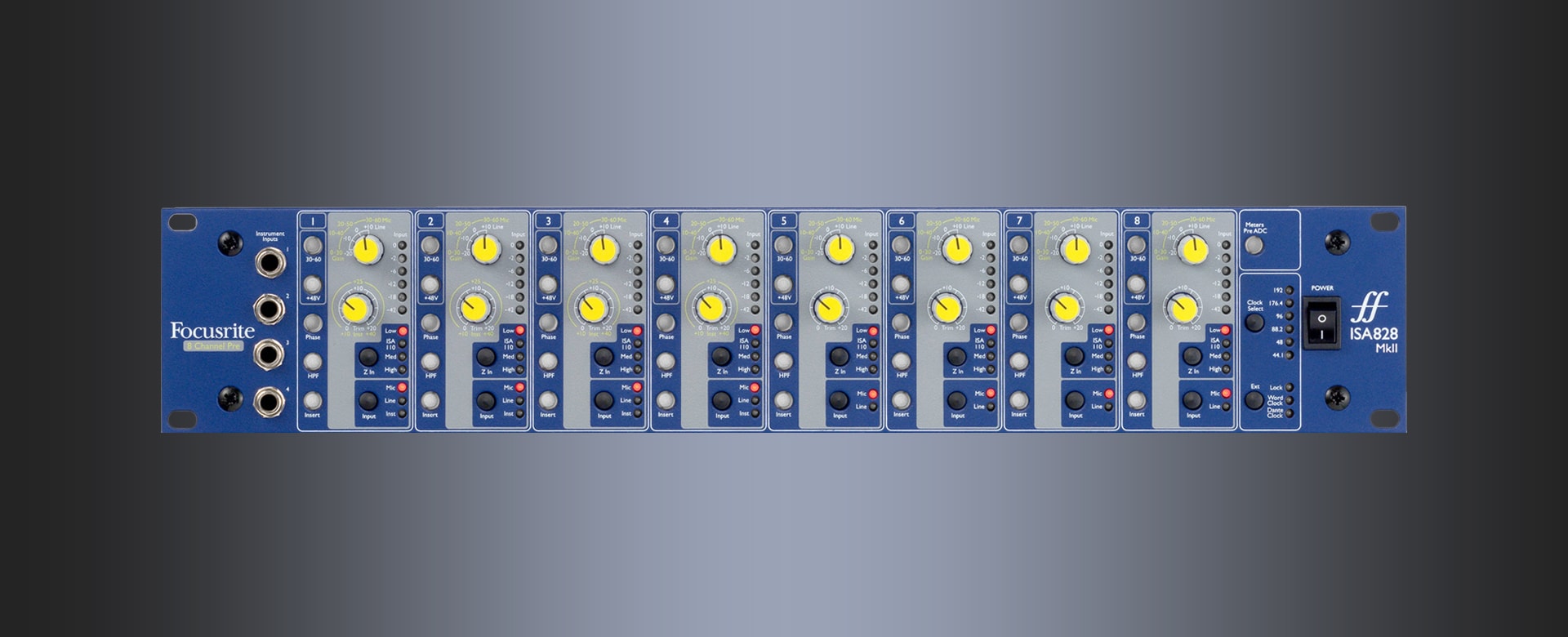ISA 828 MKII
Four Classic Mic PresProduct Highlights
- Classic ISA mic preamp design featuring Lundahl LL1538 input transformer
- Front-panel instrument inputs to first four channels
- Line inputs with dedicated input connectors and front-panel switch
- Switchable input impedance including classic ISA 110 setting
- High-pass filters
- Switchable insert points when used with A-D card
- Per-channel six-segment LED peak-level meters
- Optional A-D card with up to 192kHz, 24-bit sampling via ADAT or AES3
Focusrite ISA 828
- Overview
- Tech Specs
ISA 828 incorporates eight of Focusrite's renowned mic pres in a simple-to-operate 2U enclosure, placing four mic preamps, instrument inputs and line ins at your fingertips. The original Focusrite mic pre was designed to suit the microphones of the time; today's model makes one small change, adding three additional input impedances to the classic ISA 110 setting, allowing you to match any microphone, old or new, and access a wide range of sounds, from the character and warmth of a vintage mic to the clear transparency of a modern design.
Each mic pre has the option of mic, line or the front-panel instrument input, with variable input impedance to ensure you are getting the best performance from the source. Up to 60dB of gain is available on the four-position rotary and gain range switches, with a further +20dB of continuously variable trim, meaning a huge 80dB of gain is available should it be required. The high-pass filter features variable cut-off frequency between 16 and 420Hz. An array of 6-segment LED meters show peak signal level for the four mic pres, in addition to the four direct inputs to the optional A-D card. Switchable rear-panel insert points allow the use of inline processors such as compression.
| MIC INPUTS | |
| Gain Range (Mic) | 0 dB to 60 dB in 10 dB steps |
| Input Impedance (Mic) | Variable, 600O, 1k4O, 2k4O, 6k8O |
| Noise At Main Output With Gain At Unity (0 DB) (Mic) | -97 dBu measured with a 22 Hz / 22 kHz bandpass filter |
| Signal To Noise Ratio Relative To Max Headroom (9dBu) (Mic) | 106 dB |
| THD At Medium Gain (30dB) (Mic) | 0.0008 measured with a 1 kHz -20 dBu input signal and with a 22 Hz / 22 kHz bandpass filter |
| Frequency Response At Minimum Gain (0 DB) (Mic) | -0.5 dB down at 10 Hz and –3 dB down at 110kHz |
| Frequency Response At Maximum Gain (60 DB) (Mic) | –3 dB down at 16 Hz and –3 dB down 85 kHz |
| CMRR (Mic) | 91.8 dB (Channel 1, 1 kHz, maxiumum gain) |
| LINE INPUTS | |
| Input Impedance (Line) | 10 kO from 10 Hz to 200 kHz |
| Gain Range (Line) | -20 dB to 10 dB in 10 dB steps |
| Noise At Main Output With Gain At Unity (0 DB) (Line) | -96 dBu measured with a 22 Hz / 22 kHz bandpass filter |
| Signal To Noise Ratio Relative To Max (Line) | 120 dB |
| Signal To Noise Ratio Relative To 0dBFS( 22dBu) (Line) | 118dB |
| THD At Unity Gain (0dB) (Line) | 0.001 measured with a 0 dBu input signal and with a 22 Hz / 22 kHz bandpass filter |
| Frequency Response At Unity Gain (0dB) (Line) | 0.3 dB down at 10 Hz and –3 dB down at 122 kHz |
| INSTRUMENT INPUTS | |
| Gain Range (Instrument) | 10 dB to 40 dB continuously variable |
| Input Impedance (Instrument) | 1 MO or 300 kO |
| Noise At Minimum Gain ( 10 DB) (Instrument) | -90 dBu measured with a 22 Hz / 22 kHz bandpass filter |
| Noise At Maximum Gain ( 40 DB) (Instrument) | -62 dBu measured with a 22 Hz / 22 kHz bandpass filter |
| THD At Minimum Gain ( 10 DB) (Instrument) | 0.002 measured with a 10 dBu input signal and with a 22 Hz / 22 kHz bandpass filter |
| Frequency Response At 10 DB Gain With -10 DB Input (Instrument) | 10 Hz - 200 kHz /- 0.6 dB |
| Frequency Response At 40 DB Gain With -40 DB Input (Instrument) | -2.5 dB down at 10 Hz and 0 dB at 200 kHz |
| Roll Off | 18 dB per octave 3 pole filter |
| Frequency (Instrument) | Fixed 75Hz measured at the 3dB down point |
WEIGHT AND DIMENSIONS
- Weight: 8.84 kg (19.5 lbs)
- Dimensions (W X H X D): 484mm (W) x 85mm (H) x 305mm (D) (350mm depth with heat sink)



